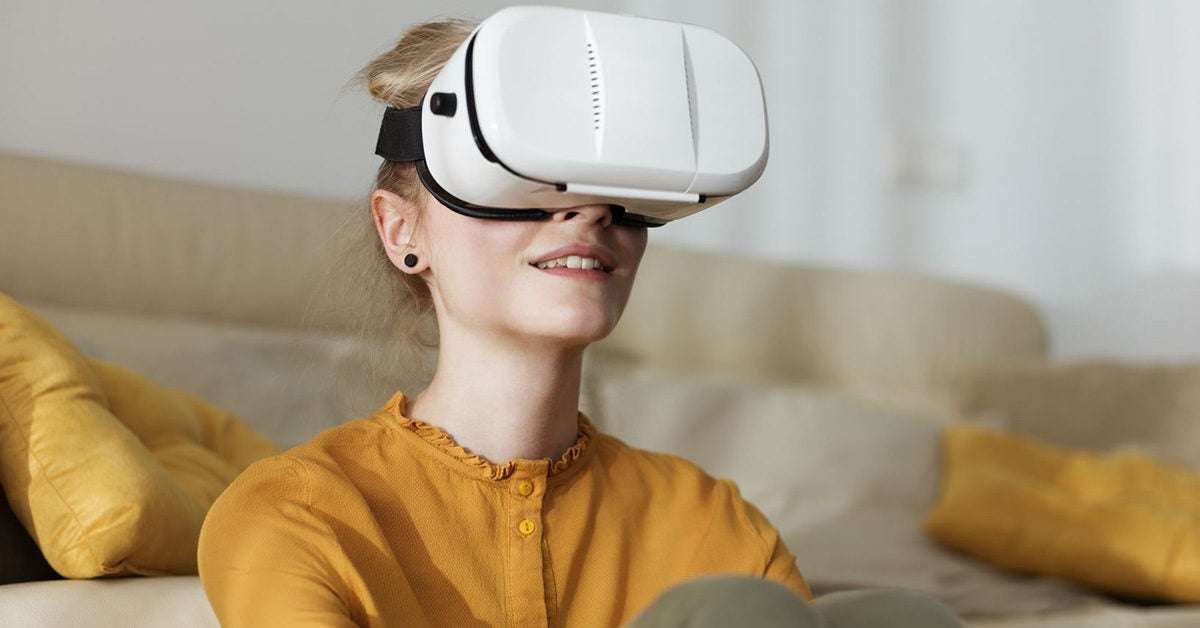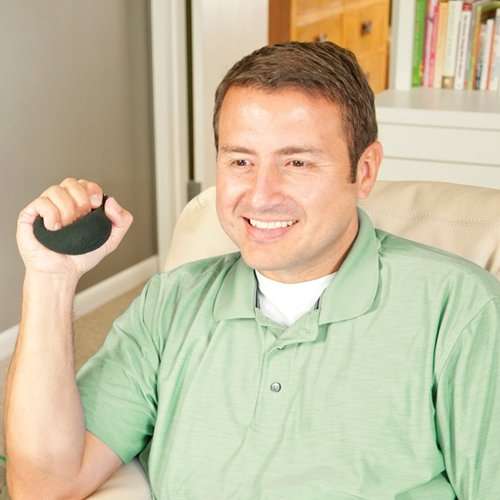
Source: Andrea Piacquadio/Pexels
New research published in JMIR Mental Health has found that virtual reality (VR) can be useful in the treatment of anxiety and depression. Virtual reality can be used effectively to augment and enhance traditional treatment methods, such as cognitive behavioral therapy and exposure therapy.
The recent study reviewed articles published between 2017 to 2021 related to virtual reality in the treatment of mental health issues and found 369 articles in this subject area, which were narrowed down to 34 clinical studies. Most of these studies combined cognitive behavioral therapy, a standard method of treating anxiety, with virtual reality immersive environments and simulations. Based on this recent review of research, VR research has primarily focused on anxiety, and there is less research on the effectiveness and use of VR in depression.
Virtual reality uses computer modeling and simulation so that people can interact with realistic 3D visual environments as well as other senses through interfaces like sensory gloves. Virtual reality in health care entered the scene in the early 2000s with the use of a VR gaming system SnowWorld which was found to be able to reduce pain levels in burn wound care.
Virtual reality combined with cognitive behavioral therapy has been effective in the treatment of social anxiety disorder, generalized anxiety disorder, as well as treatment for specific fears such as public speaking anxiety, exam anxiety, and driving-related anxiety. However, most research in this area has small participant sample sizes, ranging from 2 to 115. All the studies used head-mounted displays, as opposed to projection-based displays, to provide simulated environments.
The most common VR intervention was VR exposure therapy (VRET). Virtual reality exposure therapy is a behavioral method in which participants are deliberately shown a feared object or anxiety-provoking experience in a simulated environment. VRET has been useful to treat social anxiety and public speaking anxiety. The theory is that gradual and repeated exposure to this triggering simulated environment can reduce anxiety over time. Virtual reality provides a useful way for participants to experience safely and confidentially a simulated environment and gives people a chance to work directly with therapists in real time. For example, people with social anxiety were placed in a virtual workplace or job interview or people with a fear of public speaking were placed in a virtual classroom or conference room.
Virtual reality technology can also enhance the possibilities of music therapy. One study placed participants in a virtual performance hall where they could sing and perform. Another study used VR to enhance art therapy by using a virtual painting program. VR has also been used to conduct healthy games and exercises and as a way to provide neurofeedback and biofeedback.
As virtual reality technology continues to expand and develop, it will hopefully become more accessible to everyone. Virtual reality is a useful and novel way to enhance and make more efficient traditional forms of treatment for of anxiety and depression.
Marlynn Wei, MD, PLLC © Copyright 2021

Share on Pinterest
Health and wellness touch each of us differently. This is one person’s story.
If you had told me a year ago that my favorite relaxing activity would involve strapping a computer to my head to immerse myself in a virtual world, I never would’ve believed you.
Virtual reality (VR) may be an up-and-coming technology, but I happen to be the opposite of a techie.
In my family, I’m notorious for my argument that CDs and VHS tapes should make a comeback. My husband has been known to abscond with my ancient phone just to install much-needed updates.
Until about a year ago, VR in any form was barely on my radar. So, it’s something of a miracle that I ever got started with VR meditation, let alone that I’ve come to embrace it as a helpful tool for treating my anxiety disorder.
It all began when I received an Oculus Go VR headset as a gift, with the recommendation I try out the meditation app.
Starting out, I had low expectations. Wouldn’t the confining visual field make me feel claustrophobic? Wouldn’t I get dizzy and nauseous? If anything, it seemed like VR might increase my anxiety, not decrease it.
Still, I decided I’d give the device a whirl for as long as I could stand it — which I figured would be about 30 seconds.
Getting started with VR meditation
Slipping on the headset and opening the meditation app to the tune of gentle piano music, I was amazed to find my body’s relaxation response kicking in almost immediately.
As I settled in to my choice of environment (a bench overlooking the ocean at sunset) and music (a floaty ambient track called “refresh”), I felt the worries of my day fall away. My breathing slowed. My heart rate dropped to an even, steady beat.
I sat, breathed, and took in the rhythm of the waves for a record-breaking 40 minutes. In a word, I actually meditated — which under normal circumstances is extremely difficult for my anxious mind to do.
When I eventually removed the headset to proceed with my day, I continued to feel the calming effects of my VR meditation experience for hours.
From then on, I was hooked. I now look forward to the time I spend every other day meditating in any of the app’s numerous environments — from a wintry forest under the northern lights to a jungle pool flanked by waterfalls.
It’s as though I can access a whole secret world of peace and quiet, on demand. I use it to unwind after a long day or prepare for a stressful work call. I take it on vacation with me. It’s become the mental health lifeline I never knew I needed.
Benefits of meditation for anxiety
I shouldn’t be surprised, of course, that virtual reality meditation would help temper my anxiety. The benefits of meditation are well established for many mental health conditions, especially generalized anxiety disorder (GAD).
Research shows that mindfulness meditation reduces anxiety symptoms, improves stress reactivity, and boosts coping mechanisms in people with GAD.
One study found that after a single session of mindfulness meditation, participants experienced “significantly” less anxiety for days afterward.
For someone like me who lives in a permanent state of mental hyperarousal, meditation is a no-cost, no-risk intervention that could have major positive impact.
Why VR meditation instead of ‘regular’ meditation
The problem with anxiety, of course, is that it makes my mind extra jumpy and extra ready to yank right out of the Zen bliss of meditation and into a hurricane of worries and to-dos. For this reason, unassisted silent meditation is, I believe, particularly difficult for people with anxiety.
Virtual reality helps me overcome this by engaging my senses. With a vista of gorgeous scenery before my eyes and music in my ears, I’m far better able to center myself in the moment than when I try to clear my head of my own volition.
VR gives me something to focus on besides the anxious or intrusive thoughts that constantly vie for headspace.
And “gently bringing my attention back to the present,” as meditation scripts like to say, isn’t nearly so difficult when I can’t see the clutter in my bedroom or hear my kids arguing in the next room.
In addition to immersing myself in a sensory experience, simply having a large physical device on my face is a deterrent to distraction. The act of putting it on sets the expectation in my body and mind that now it’s time to be calm.
Plus, the fact that it’s a stand-alone device keeps me more accountable, so I actually stick with a meditation session for its entire duration. I’m far less likely to check the time or my Facebook notifications while using the Oculus than when I’m trying to meditate using YouTube or an app on my phone.
It may seem lame, but I even prefer VR meditation over meditation in nature. When I try to quiet my mind in real natural settings, I find my anxiety still gets in the way.
I could sit on a mossy log in a serene forest and I’d worry that a bug would crawl up and sting me. On a tranquil sandy beach, I’m paranoid that a seagull will fly over and poop on my head.
So, as much as I’d love to peacefully contemplate the beauty of a flowery meadow or rippling stream — since spending time in nature has been shown to help with stress reduction — in my current state of mental health, it’s simply not likely.
I’ve come to accept that I get more out of experiencing the sense of natural settings from the comfortable, private, bug-and-seagull-free zone of my own bed.
Last word
One day I’d love to be able to turn down the noise in my own head without assistance. It would be amazing to achieve “om” in silence on a mountaintop.
But for now, I see virtual reality as a tool that helps me bridge the gap between that ideal and my reality. Some people might call it “cheating” at meditation. I simply call it relief.
Share on Pinterest
Sarah Garone, NDTR, is a nutritionist, freelance health writer, and food blogger. She lives with her husband and three children in Mesa, Arizona. Find her sharing down-to-earth health and nutrition info and (mostly) healthy recipes at A Love Letter to Food.




